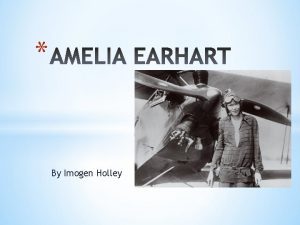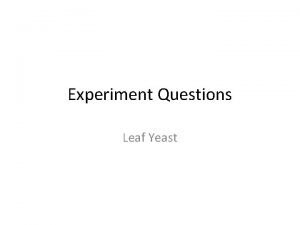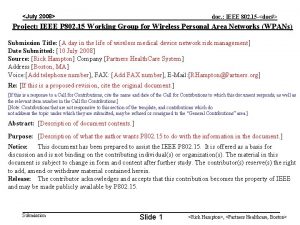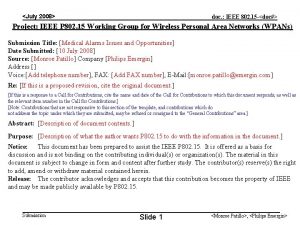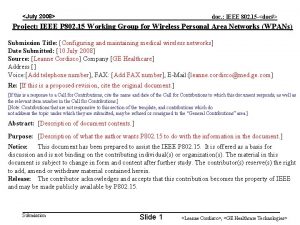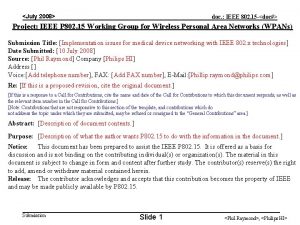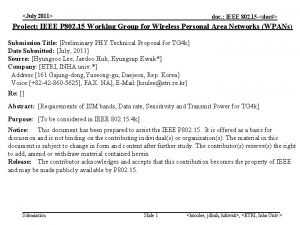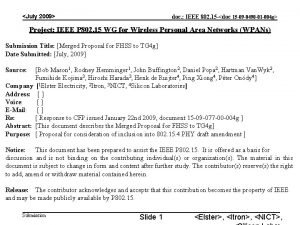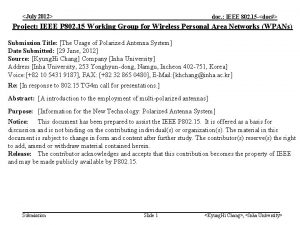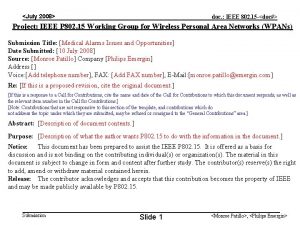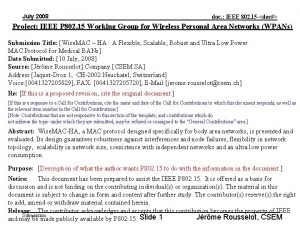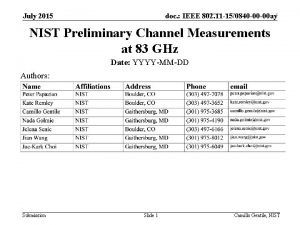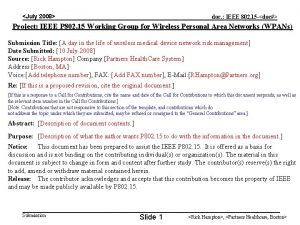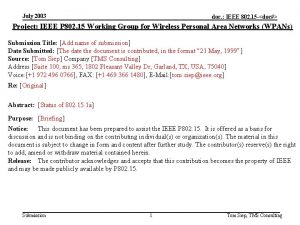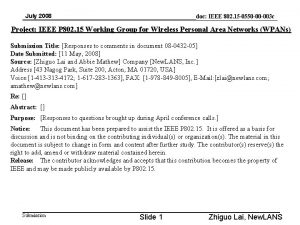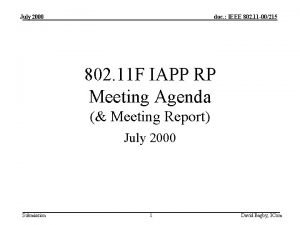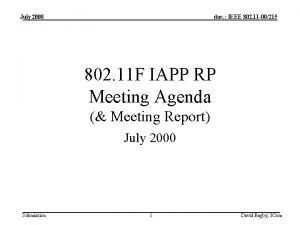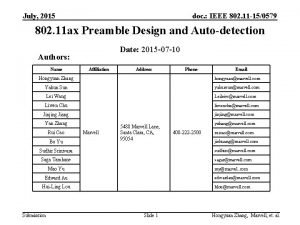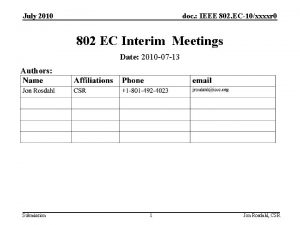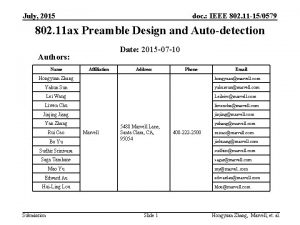July 2016 doc IEEE 802 11 160955 r



















![July 2016 doc. : IEEE 802. 11 -16/0955 r 0 References [1] IEEE P July 2016 doc. : IEEE 802. 11 -16/0955 r 0 References [1] IEEE P](https://slidetodoc.com/presentation_image/1e881a29b80432f27070529e9cf9ae72/image-20.jpg)

- Slides: 21

July 2016 doc. : IEEE 802. 11 -16/0955 r 0 Non-Uniform HOM Constellations for 11 ay Single Carrier Date: 2016 -07 -25 Authors: Submission Slide 1 Yan Xin, Huawei Technologies

July 2016 doc. : IEEE 802. 11 -16/0955 r 0 Introduction • The squared (uniform) 64 QAM modulation has been accepted in IEEE 802. 11 REVmc Draft 5. 4 [1] for 11 ad single carrier. • It has been well-known that the squared 64 QAM modulation can yield reasonable error rate performance with simplementation. However, due to its geometric representation of constellations, the impairments of phase noise and PA non-linearity may significantly degrade the performance of the squared 64 QAM. • Other non-uniform constellation modulation schemes have been extensively investigated. Some of non-uniform constellations have been accepted in the standards such as the APSK modulation in DVB-S 2 X [2]. • Some 64 -point non-uniform constellations (NUCs) have been proposed for 11 ay SC [3]-[6]. • This presentation evaluates several 64 -point non-uniform constellations for 11 ay SC, which are optimized with consideration of AWGN and AWGN+phase noise impairments. • Simulation results demonstrate that all the 64 -point non-uniform constellations proposed in this presentation can yield significant performance gains compared to the squared 64 QAM and 64 APSK in DVB-S 2 X. Submission Slide 2 Yan Xin, Huawei Technologies

July 2016 doc. : IEEE 802. 11 -16/0955 r 0 Design Criteria of NUCs • To improve robustness of constellations against phase noise. • To maintain the increase in complexity within a moderate level. Submission Slide 3 Yan Xin, Huawei Technologies

July 2016 doc. : IEEE 802. 11 -16/0955 r 0 Example of NUC: 64 -APSK in DVB-S 2 X [2] Submission Code rate Modulation/coding spectral efficiency R 1 R 2 R 3 7/9 4. 65 2. 2 3. 6 5. 2 Slide 4 Yan Xin, Huawei Technologies

July 2016 doc. : IEEE 802. 11 -16/0955 r 0 Design of New NUCs • Mutual Information and Pragmatic Mutual Information ü The ultimate performance of a given modulation set (constellation) over a channel under ideal detection and decoding can be computed using the Mutual Information (MI) or the Pragmatic Mutual Information (PMI) B=(B 1, …, Bm) X=x(B) U binary Encoder rc Mapping X Channel Y m ü It is an upper bound on the maximum spectral efficiency r=mrc Submission Slide 5 Yan Xin, Huawei Technologies

July 2016 doc. : IEEE 802. 11 -16/0955 r 0 May 2015 Transmitter and Receiver of Pragmatic Approach binary decoder Submission Slide 6 Yan Xin, Huawei Technologies

July 2016 doc. : IEEE 802. 11 -16/0955 r 0 Consideration of Phase Noise and PA Nonlinearity Constraints • AWGN: • White Phase noise: • Ideal non linearity : To limit the peak power Submission Slide 7 Yan Xin, Huawei Technologies

July 2016 doc. : IEEE 802. 11 -16/0955 r 0 May 2015 Optimized Constellations (AWGN with Phase Noise) (1) Rate 3/4 Rate 5/8 Submission Slide 8 Yan Xin, Huawei Technologies

July 2016 doc. : IEEE 802. 11 -16/0955 r 0 May 2015 Optimized Constellations (AWGN with Phase Noise) (2) Rate 7/8 Rate 13/16 Submission Slide 9 Yan Xin, Huawei Technologies

July 2016 doc. : IEEE 802. 11 -16/0955 r 0 May 2015 Optimized Constellations (AWGN with Phase Noise and PA Nonlinearity) (1) Rate 3/4 Rate 5/8 Submission Slide 10 Yan Xin, Huawei Technologies

July 2016 doc. : IEEE 802. 11 -16/0955 r 0 May 2015 Optimized Constellations (AWGN with Phase Noise and PA Nonlinearity) (2) Rate 7/8 Rate 13/16 Submission Slide 11 Yan Xin, Huawei Technologies

July 2016 doc. : IEEE 802. 11 -16/0955 r 0 May 2015 Simulation Assumptions • 64 -point constellations with 11 ad LDPC code of rates 5/8, 3/4 and 13/16 • SC modulation • Packet length: 4096 bytes • LDPC iterations: 6 • AWGN channel • 11 ad phase noise model Submission Slide 12 Yan Xin, Huawei Technologies

July 2016 doc. : IEEE 802. 11 -16/0955 r 0 May 2015 FER Performance (1) • AWGN: Rate 5/8 For the case of code rate 5/8, the 64 -OPT-SNR-rate 7/8 constellations yield about 0. 21 d. B gain w. r. t. 64 QAM and about 0. 2 d. B gain w. r. t. DVB S 2 X at 1% FER. Submission Slide 13 Yan Xin, Huawei Technologies

July 2016 doc. : IEEE 802. 11 -16/0955 r 0 May 2015 FER Performance (2) • AWGN : rate 3/4 For the case of code rate 3/4, the 64 -OPT-SNR-rate 7/8 constellations yield performance gains of 0. 15 d. B, and 0. 16 d. B at 1% FER compared to DVB S 2 X and 64 QAM, respectively. Submission Slide 14 Yan Xin, Huawei Technologies

July 2016 doc. : IEEE 802. 11 -16/0955 r 0 May 2015 FER Performance (3) • AWGN : rate 13/16 For the case of code rate 13/16, All the constellations nearly have the same performances. Submission Slide 15 Yan Xin, Huawei Technologies

July 2016 doc. : IEEE 802. 11 -16/0955 r 0 May 2015 FER Performance (4) • AWGN with Phase Noise: Rate 5/8 For the case of code rate 5/8, the 64 -OPT-SNR-rate 5/8 constellations yield about 0. 61 d. B gain w. r. t. 64 QAM, about 0. 5 d. B gain w. r. t. DVB S 2 X, about 0. 51 d. B gain w. r. t. SONY New and result in 0. 18 d. B performance loss compared to SONY Cat. D rate 5/8 at 1% FER. Alternatively, the 64 -OPT-SNR-rate 7/8 constellations yield about 0. 58 d. B gain w. r. t. 64 QAM, about 0. 49 d. B gain (est. ) w. r. t. DVB S 2 X, about 0. 5 d. B gain (est. ) w. r. t. SONY New, and result in 0. 21 d. B performance loss compared to SONY Cat. D rate 5/8. Submission Slide 16 Yan Xin, Huawei Technologies

July 2016 doc. : IEEE 802. 11 -16/0955 r 0 May 2015 FER Performance (5) • AWGN with Phase Noise: rate 3/4 For the case of code rate 3/4, the 64 -OPT-SNR-rate 7/8 constellations yield performance gains of 0. 2 d. B, 0. 4 d. B , 0. 9 d. B, 0. 41 d. B (est. ) and 0. 82 d. B (est. ) at 1% FER compared to 64 -OPT-SNR-rate 3/4, SONY Cat. D rate ¾ and 64 QAM, SONY New, DVB S 2 X respectively. Submission Slide 17 Yan Xin, Huawei Technologies

July 2016 doc. : IEEE 802. 11 -16/0955 r 0 May 2015 FER Performance (6) • AWGN with Phase Noise: rate 13/16 For the case of code rate 13/16, the 64 -OPT-SNR-rate 7/8 constellations yield performance gains of 0. 17 d. B, 0. 5 d. B, 0. 8 d. B (est. ), 1. 5 d. B (est. ), and 1. 6 d. B at 1% FER compared to 64 -OPT-SNR-rate 13/16, SONY Cat. D rate 13/16, SONY New, DVB S 2 X and 64 QAM, respectively. Submission Slide 18 Yan Xin, Huawei Technologies

July 2016 doc. : IEEE 802. 11 -16/0955 r 0 Summary • Simulation shows that the non-uniform constellations (NUCs) proposed in this presentation and the NUCs proposed in [3]-[6] can significantly improve the error rate performance of the uniform (squared) QAM constellations (up to 1. 6 d. B) and DVB S 2 X constellations (up to 1. 5 d. B). • The performance of the NUCs proposed in this presentation are also compared with the NUCs in [3]-[6]. In most cases (different code rates and impairment setups), the NUCs proposed in this presentation result in better performance than the NUCs [3]-[6]. • NUCs should be considered to be used in 11 ay especially for relatively higher order modulation, such as 64 -point modulation, which may be significantly impacted by phase noise. Submission Slide 19 Yan Xin, Huawei Technologies
![July 2016 doc IEEE 802 11 160955 r 0 References 1 IEEE P July 2016 doc. : IEEE 802. 11 -16/0955 r 0 References [1] IEEE P](https://slidetodoc.com/presentation_image/1e881a29b80432f27070529e9cf9ae72/image-20.jpg)
July 2016 doc. : IEEE 802. 11 -16/0955 r 0 References [1] IEEE P 802. 11 -REVmc. TM/D 5. 4, May 2016. [2] ETSI DVB-S 2 Extensions (DVB-S 2 X), October 2014. [3] 11 -15 -0096 -01 -ng 60 Non-uniform Constellations for higher Order QAMs. [4] 11 -15 -0601 -00 -00 ay Non-uniform Constellations for 64 QAM. [5] 11 -15 -0835 -00 -00 ay-potential-of-non-uniform-constellations-withpeak-power-constraint. [6] 11 -16 -0072 -00 -00 ay-performance-of-non-uniform-constellations-inpresence-of-phase-noise. Submission Slide 20 Yan Xin, Huawei Technologies

July 2016 doc. : IEEE 802. 11 -16/0955 r 0 Straw Poll/Motion • Do you agree to insert “A 64 -point non-uniform constellation shall be included in the 11 ay specification” in 11 ay SFD? Yes: No: Abstain: Submission Slide 21 Yan Xin, Huawei Technologies
 Bridges from 802.x to 802.y
Bridges from 802.x to 802.y Bridges from 802.x to 802.y
Bridges from 802.x to 802.y Ieee 802 bluetooth
Ieee 802 bluetooth 802 ieee
802 ieee Ieee 802
Ieee 802 Ieee 802 family
Ieee 802 family Ieee 802 3 compliance
Ieee 802 3 compliance Ieee802.22
Ieee802.22 Arquitetura ieee 802
Arquitetura ieee 802 Ieee 802 que es
Ieee 802 que es Ieee 802 standard
Ieee 802 standard Malaga in july
Malaga in july July 2 1937 amelia earhart
July 2 1937 amelia earhart On july 18 2001 a train carrying hazardous chemicals
On july 18 2001 a train carrying hazardous chemicals The cuban melodrama
The cuban melodrama Astronomy picture of the day 11 july 2001
Astronomy picture of the day 11 july 2001 Tender mean
Tender mean Super saturday tribal bingo july 4
Super saturday tribal bingo july 4 Sergei korolev
Sergei korolev Sources nso frenchhowell neill mit technology...
Sources nso frenchhowell neill mit technology... Growth of leaf yeast experiment
Growth of leaf yeast experiment Oscar and alphonse harris burdick
Oscar and alphonse harris burdick












